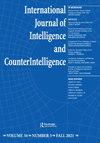Helping Intelligence Analysts Gain Insight
IF 0.5
Q4 INTERNATIONAL RELATIONS
International Journal of Intelligence and Counterintelligence
Pub Date : 2023-10-05
DOI:10.1080/08850607.2023.2257549
引用次数: 0
Abstract
AbtractDecisionmakers expect intelligence assessments to be insightful. Still, intelligence professionals do not understand the insight process well enough to achieve consistently such indispensable outcomes. Little, if any, research has studied how intelligence analysts achieve insights. A qualitative, interview-based unclassified study was conducted to understand how insight emerges in 36 intelligence analysts who solved novel problems. The results include an emergence process consisting of two interacting elements—internalized tensions and priming—across the emotion–cognition and individual–social dimensions, and that the relationship between the two elements is complex. The emergence of insight is not predictable or controllable, which has significant challenges for the management of intelligence analysts because intelligence agencies typically are hierarchical organizations that emphasize order and control, conditions antithetical for nurturing emergence. This conundrum requires a major individual and cultural shift by management. The study suggests that the findings are generalizable across intelligence analysts in any national security organization, domestic or international. Disclosure statementNo potential conflict of interest was reported by the author(s).Notes1 Thomas H. Kean and Lee Hamilton, The 9/11 Commission Report: Final Report of the National Commission on Terrorist Attacks upon the United States (Washington, DC: U.S. Government Printing Office, 2004), p. 339. https://www.9-11commission.gov/report/; Laurence H. Silberman and Charles S. Robb, The Commission on the Intelligence Capabilities of the United States Regarding Weapons of Mass Destruction (Washington, DC: U.S. Government Printing Office, 2005), p. 560. https://www.govinfo.gov/app/details/GPO-WMD2 Jacob W. Getzels and Mihalyi Csikszentmihalyi, “From Problem Solving to Problem Finding,” in Perspectives in Creativity, edited by Irving A. Taylor and Jacob W. Getzels (Chicago, IL: Aldine, 1975), pp. 90–115.3 Robert J. Sternberg, “A Three-Facet Model of Creativity,” in The Nature of Creativity, edited by Robert J. Sternberg (Cambridge, UK: Cambridge University Press, 1988), pp. 125–147.4 Stephen Marrin, “Understanding and Improving Intelligence Analysis by Learning from Others,” Intelligence and National Security, Vol. 32, No. 5 (2017), pp. 539–547. https://doi.org/10.1080/02684527.2017.1310913; Joseph Soeters, Management and Military Studies: Classical and Current Foundations (New York: Routledge, 2020), pp. 1–10.5 Peter A. Corning, “The Re-Emergence of ‘Emergence’: A Venerable Concept in Search of a Theory,” Complexity, Vol. 7, No. 6 (2002), pp. 18–30. https://doi.org/10.1002/cplx.100436 Steve W. J. Kozlowski and Katherine J. Klein, “A Multilevel Approach to Theory and Research in Organizations: Contextual, Temporal, and Emergent Processes,” in Multilevel Theory, Research, and Methods in Organizations: Foundations, Extensions, and New Directions, edited by Katherine J. Klein and Steve W. J. Kozlowski (San Francisco, CA: Jossey-Bass, 2000), pp. 3–90.7 Gary Klein and Andrea Jarosz, “A Naturalistic Study of Insight,” Journal of Cognitive Engineering and Decision Making, Vol. 5, No. 4 (2011), pp. 335–351. https://doi.org/10.1177/15553434114270138 Bruno Latour, Science in Action: How to Follow Scientists and Engineers through Society (Cambridge, MA: Harvard University Press, 1987), pp. 2–3.9 Mihaly Csikszentmihalyi and Keith Sawyer, “Creative Insight: The Social Dimension of a Solitary Moment,” in The Nature of Insight, edited by Robert J. Sternberg and Janet E. Davidson (Cambridge, MA: MIT Press, 1995), pp. 329–363.10 Stellan Ohlsson, “Information-Processing Explanations of Insight and Related Phenomena,” in Advances in the Psychology of Thinking, edited by Mark T. Keane and Kenneth J. Gilhooly (Hempstead, UK: Harvester Wheatsheaf, 1992), pp. 1–44; Stellan Ohlsson, “The Dialectic between Routine and Creative Cognition,” in Insight: On the Origins of New Ideas, edited by Frederic Vellee-Tourangeau (New York: Routledge, 2018), pp. 8–29.11 Ivan K. Ash, Benjamin D. Jee, and Jennifer Wiley, “Investigating Insight as Sudden Learning,” Journal of Problem Solving, Vol. 4, No. 2 (2012), pp. 1–27. https://doi.org/10.7771/1932-6246.1123.12 Ibid.13 Ohlsson, “Information-Processing Explanations of Insight and Related Phenomena,” pp. 1–44.14 Ibid.15 Daniel Kahneman, Thinking, Fast and Slow (New York: Farrar, Straus and Giroux, 2011), pp. 19–30; William Taggart and Daniel Robey, “Minds and Managers: On the Dual Nature of Human Information Processing and Management,” Academy of Management Review, Vol. 6, No. 2 (1981), pp. 187–195. https://doi.org/10.5465/amr.1981.4287774; Michael L. Tushman and David A. Nadler, “Information Processing as an Integrating Concept in Organization Design,” Academy of Management Review, Vol. 3, No. 3 (1978), pp. 613–624. https://doi.org/10.5465/amr.1981.428777416 Leon Festinger, A Theory of Cognitive Dissonance (Stanford, CA: Stanford University Press, 1957), p. 9.17 John A. Bargh and Tanya L. Chartrand, “Studying the Mind in the Middle: A Practical Guide to Priming and Automaticity Research,” in Handbook of Research Methods in Social and Personality Psychology, edited by Harry T. Reis and Charles M. Judd (New York: Cambridge University Press, 2000), pp. 253–285.18 Seana Moran, “Metaphor Foundations in Creativity Research: Boundary vs. Organism,” Journal of Creative Behavior, Vol. 43, No. 1 (2009), pp. 1–28. https://doi.org/10.1002/j.2162-6057.2009.tb01303.x19 Thomas Fingar, Reducing Uncertainty: Intelligence Analysis and National Security (Stanford, CA: Stanford Security Studies, 2011), pp. 1–18.20 Office of the Director of National Intelligence, Intelligence Community Directive 203, Analytic Standards, 2 January 2015, https://www.dni.gov/files/documents/ICD/ICD%20203%20Analytic%20Standards.pdfAdditional informationNotes on contributorsAdrian WolfbergAdrian Wolfberg began his intelligence career as an EA-3B jet aircraft carrier–based naval flight officer and, then, as a civilian intelligence analyst. Adrian’s research has concentrated on challenges within large, complex organizations where knowledge exchange between producers of knowledge and senior-level decisionmakers receive, absorb, and process knowledge. He received his Ph.D. from Case Western Reserve University’s Weatherhead School of Management, and a Master of Science in National Security Strategy from the National War College. The author can be contacted at awolfberg@gmail.com帮助情报分析师获得洞察力
决策者期望情报评估具有洞察力。尽管如此,情报专业人员对洞察过程的了解还不够充分,无法持续实现这些不可或缺的结果。很少有研究研究情报分析师是如何获得洞见的。我们进行了一项定性的、基于访谈的非分类研究,以了解36名解决新问题的情报分析师是如何产生洞察力的。结果表明,在情绪认知和个人社会维度上,出现了一个由两个相互作用的因素——内化紧张和启动——组成的出现过程,这两个因素之间的关系是复杂的。洞察力的出现是不可预测或可控的,这对情报分析人员的管理构成了重大挑战,因为情报机构通常是强调秩序和控制的等级组织,而这些条件与培养洞察力是对立的。这个难题需要管理层在个人和文化上做出重大转变。该研究表明,这些发现适用于任何国家安全组织的情报分析师,无论是国内还是国际。披露声明作者未报告潜在的利益冲突。注1 Thomas H. Kean和Lee Hamilton,《9/11委员会报告:美国恐怖袭击国家委员会的最终报告》(华盛顿特区:美国政府印刷局,2004年),第339页。https://www.9-11commission.gov/report/;Laurence H. Silberman和Charles S. Robb,《美国关于大规模杀伤性武器的情报能力委员会》(华盛顿特区:美国政府印刷局,2005年),第560页。https://www.govinfo.gov/app/details/GPO-WMD2 Jacob W. Getzels和Mihalyi Csikszentmihalyi,“从解决问题到发现问题”,见Irving A. Taylor和Jacob W. Getzels编辑的《创造力的视角》(芝加哥,IL: Aldine, 1975),第90-115.3页。Robert J. Sternberg,“创造力的三方面模型”,见《创造力的本质》,Robert J. Sternberg编辑的《创造力的本质》(剑桥,英国)。斯蒂芬·马林,《通过向他人学习来理解和改进情报分析》,《情报与国家安全》,第32卷,第5期(2017),第539-547页。https://doi.org/10.1080/02684527.2017.1310913;约瑟夫·索特斯,《管理与军事研究:古典与现代基础》(纽约:劳特利奇,2020),第1-10.5页。彼得·A·康宁,“‘涌现’的重新出现:一个寻求理论的可敬概念”,《复杂性》,第7卷,第6期(2002),第18-30页。https://doi.org/10.1002/cplx.100436 Steve W. J. Kozlowski和Katherine J. Klein,“组织中理论和研究的多层次方法:语境、时间和突发过程”,《组织中的多层次理论、研究和方法:基础、扩展和新方向》,由Katherine J. Klein和Steve W. J. Kozlowski编辑(旧金山,CA);Gary Klein和Andrea Jarosz,“洞察力的自然主义研究”,《认知工程与决策杂志》,第5卷,第4期(2011),第335-351页。https://doi.org/10.1177/15553434114270138布鲁诺·拉图尔,科学在行动:如何跟随科学家和工程师通过社会(剑桥,马萨诸塞州:哈佛大学出版社,1987年),第2-3.9米哈里·奇克森特米哈里和基思·索耶,“创造性的洞察力:孤独时刻的社会维度”,在洞察力的本质,由罗伯特J.斯滕伯格和珍妮特E.戴维森编辑(剑桥,马萨诸塞州:斯特兰·奥尔森,“洞察力和相关现象的信息处理解释”,载于马克·t·基恩和肯尼斯·j·吉尔胡利编辑的《思维心理学进展》(亨普斯特德,英国:收割机麦穗,1992),第1-44页;斯特兰·奥尔森,“常规与创造性认知之间的辩证法”,载于洞察力:关于新思想的起源,由弗雷德里克·韦利-图朗高编辑(纽约:劳特利奇出版社,2018年),第8-29.11页。伊万·阿什,本杰明·d·吉和詹妮弗·威利,“调查洞察力作为突然学习”,《问题解决杂志》,第4卷,第2期(2012年),第1-27页。https://doi.org/10.7771/1932-6246.1123.12同上13 Ohlsson,“洞察力和相关现象的信息处理解释”,第1-44.14页同上15 Daniel Kahneman, Thinking, Fast and Slow(纽约:Farrar, Straus and Giroux出版社,2011),第19-30页;William Taggart和Daniel Robey,“思想和管理者:关于人类信息处理和管理的双重性”,《管理评论学会》,第6卷,第2期(1981),第187-195页。https://doi.org/10.5465/amr.1981.4287774;Michael L. Tushman和David A. Nadler,“信息处理作为组织设计中的集成概念”,《管理评论》,1978年第3卷第3期,第613-624页。https://doi.org/10.5465/amr.1981。 428777416 Leon Festinger,《认知失调理论》(斯坦福,加州:斯坦福大学出版社,1957年),第9.17页。John A. Bargh和Tanya L. Chartrand,“在中间研究心灵:启动和自动性研究的实用指南”,《社会和人格心理学研究方法手册》,Harry T. Reis和Charles M. Judd编辑(纽约:剑桥大学出版社,2000年),第253-285.18页。《边界与有机体》,《创造行为杂志》,第43卷,第1期(2009),第1 - 28页。https://doi.org/10.1002/j.2162-6057.2009.tb01303.x19 Thomas Fingar,《减少不确定性:情报分析与国家安全》(斯坦福,CA)《斯坦福安全研究》,2011年),第1-18.20页。国家情报总监办公室,情报共同体指令203,《分析标准》,2015年1月2日,https://www.dni.gov/files/documents/ICD/ICD%20203%20Analytic%20Standards.pdfAdditional信息。关于投稿人的说明。sadrian Wolfberg开始他的情报生涯时是一名EA-3B喷气式航空母舰海军飞行军官,然后是一名民用情报分析师。Adrian的研究集中在大型复杂组织中的挑战,在这些组织中,知识生产者和高级决策者之间的知识交换接受、吸收和处理知识。他在凯斯西储大学韦瑟黑德管理学院获得博士学位,在国家战争学院获得国家安全战略理学硕士学位。可以通过awolfberg@gmail.com与作者联系
本文章由计算机程序翻译,如有差异,请以英文原文为准。
求助全文
约1分钟内获得全文
求助全文
来源期刊

International Journal of Intelligence and Counterintelligence
INTERNATIONAL RELATIONS-
CiteScore
1.00
自引率
22.20%
发文量
102
 求助内容:
求助内容: 应助结果提醒方式:
应助结果提醒方式:


